Principal Matt Renwick is sharing weekly reflections about an afternoon computer club he and a teacher are sponsoring as an enrichment activity. (Here are the links to this eight-part series: Part 1, Part 2, Part 3, Part 4, Part 5, Part 6 and Part 7 and Part 8.)
In week six of our afterschool enrichment experiment, my teaching colleague and I began asking ourselves, How do we transition from consumers to creators? Here is what sparked the reflection:
In our last post, we noted how our students were very engaged with Minecraft, needing very little direction in how to play or how to play together. We should have knocked on wood.
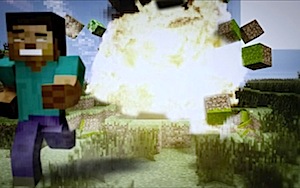 We discovered that students were joining others’ worlds without permission. Supplies were getting stolen. We were reverting back to how we began: A lack of focus, with little adherence to the group norms we developed together.
We discovered that students were joining others’ worlds without permission. Supplies were getting stolen. We were reverting back to how we began: A lack of focus, with little adherence to the group norms we developed together.
So why was this happening? Were they getting bored? One theory was, if all they do is play Minecraft, and even if they are creating worlds, are they really making anything? Were students a part of a learning process, or just consumers along for the digital ride?
It didn’t help that there really wasn’t an audience for their finished product. The past collaborations were now being weakened by unhealthy competition and demonstrations of power.
So we made the bold move of putting away the iPads (and by default Minecraft) for a while. In its place: Legos.
Instructions Not Included
I hauled the Lego Education boxes out of the school basement during the day. Once the students came in to the library, we quickly informed them of the change. Although there were a few groans, I was surprised that there wasn’t more disappointment.
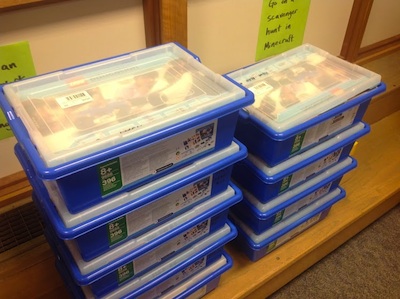
The students opened up their kits to find lots of Legos pieces and little else. “Where are the directions?” I looked in one of the kits myself and responded, “I don’t know.” These were ordered through a grant before I became principal. Each kit also included a battery-powered motor, apparently designed to move a student-constructed vehicle forward. After a brief lesson on how these moving parts might work together, the students dived in.
Invent to Learn
Sylvia Libow Martinez and Gary Stager have written one of the best resources I have read on student learning and engagement. In Invent to Learn: Making, Tinkering, and Engineering in the Classroom (Constructing Modern Knowledge Press, 2013), the authors offer practical advice for educators looking to connect hands-on with minds-on learning.
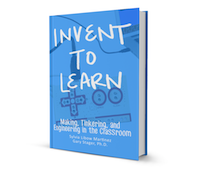 They advocate for students to have access to makerspaces. These are not specific labs or rooms, but rather environments that “share the ideals of making, tinkering, collaborative learning, and invention” (Martinez and Stager, Kindle location 224).
They advocate for students to have access to makerspaces. These are not specific labs or rooms, but rather environments that “share the ideals of making, tinkering, collaborative learning, and invention” (Martinez and Stager, Kindle location 224).
Often, makerspaces are comprised of a combination of high tech and low tech materials. But these learning environments are more than just a playground. There is purpose in what students construct and make.
“This is much more than ‘hands-on’ learning,” they write. “The ‘meaningful’ part of constructionism is not just touch-feely new age language. It acknowledges that the power of making something comes from a question or impulse that the learner has, and is not imposed from the outside” (Kindle location 828).
Our students definitely have questions and impulses, but maybe not a purpose or audience.
Passion Profile: Cole
The builders would have a clear goal in mind: Have their Lego car they create travel the length of the hallway by the Library Media Center. We made a badge in Edmodo called the “Golden Brick,” awarded to those who were able to build a vehicle that would go the distance. Cole was one of our more motivated makers. After a day, he showed me his first success.
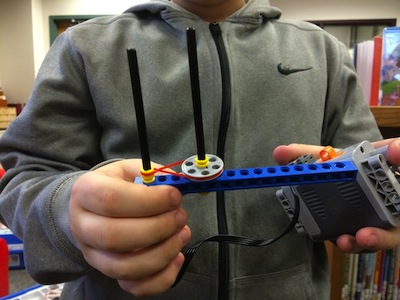
“I put this rubber band thingy around the wheels to make it go.” Success! But we didn’t let him rest on his accomplishment. We kept asking Cole and the rest of our students to consider what the next step might be to make it better.
“Where will you put the wheels?” I inquired. Cole gave me a puzzled look for a second, then his eyes lit up, and he walked quickly back to his workspace.
This process of sharing, asking, reflecting, and improving lasted for the remainder of our session. Near the end, Cole felt he was finally ready to test his creation.
This is actually a 30-second compilation of his four trials. The first trial cannot be seen because it went backward. As well, what we don’t see are the conversations and feedback that occurred in between each trial. I recorded each attempt and played the footage back for him to review. Cole’s learning was happening while he was creating – and really, inventing.
Next Steps: More Q’s than A’s
This far into our after school enrichment club, one would think we would have a lot more answers than questions. But the inverse seems to be true. For example:
â–¶ When we engage in software like Minecraft, do our learners also need a clear purpose to go along with it? If so, who decides that purpose?
â–¶ Are we being truly inventive and learning when creating worlds within Minecraft? Who serves as that audience to help determine our success?
â–¶ Will a better purpose and relevant audience help guide our learners to become more creators instead of consumers?
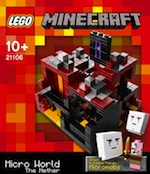 â–¶ How could a low tech tool, such as Legos, be combined with high tech such as Minecraft to make something original and connected to the school curriculum?
â–¶ How could a low tech tool, such as Legos, be combined with high tech such as Minecraft to make something original and connected to the school curriculum?
â–¶ When we integrate technology, such as Minecraft, into the traditional school environment, do we automatically assume the outcomes will be better?
â–¶ Where should the majority of our work as teachers reside: In the planning for fun activities and later assessing them, or in preparing for what’s possible by thinking about our learners and the appropriate tools they can use to create their learning?
As our club comes to a close in the next couple of weeks, these are things my colleague and I will be pondering.
Matt Renwick
Latest posts by Matt Renwick (see all)
- How Do Digital Portfolios Help Students Learn? - August 1, 2014
- Should We Unconnect from Our PLNs Over Summer Break? - July 3, 2014
- Passion-Based Learning, Week 8: The End of the Beginning - April 30, 2014


I appreciate your thoughts. I’m a librarian, and I run a minecraft club as an after school activity. Just before I read this article, a member of the club was giving me his own evaluation of what was happening with the club. I also talked about my dream of creating a city of blocks. You are right, there is more griefing, trolling, and blowing things up, than creation.
You have given me some things to think about.
Thank you for sharing, Dana. Very wise of you to get feedback from one of your students on your club. Did you find any commonalities between your two lines of thinking?
My son plays Minecraft in creative mode a lot of time. He has created many things, installed a server, modified it for Hungry Games, installed a VPN, programmed a password protected door in a building he has made. He has learnt a lot, by himself, as millions of youngsters around the world.
Then we see them, and think on all wonderful things they can do in school with it. We set everything, according to our wise judgement, and it does not work. They do things we do not like them to do. They get bored!
So we wonder if the problem is in Minecraft…
Wow, your son is doing some amazing work. I didn’t know you could password protect a door in Minecraft.
You hit on the struggle we also have with connecting these games to the curriculum. If we run this club in the future, we may approach it with more clear goals. We’ve seen what the students can and want to do, so now let’s design learning opportunities around their interests and skills. This first year has really been a “sit back and observe” type of experience. Very informative, and yet only the beginning.
Thanks Rafael for your comment.
Matt, What you wrote here really related to the “tech” programs that are found in high schools. I am currently a student teacher Brock and my teachable subject is Transportation Technology, and this hands on approach is kind of teaching that takes place in the transportation classrooms.
Allowing the students to use their hands and work on cars is our gateway to teaching them literacy, mathematics, science and every other subject. Its a real shame that these tech programs are not mandatory for a high school diploma when they work so well with students who just cant grasp the theories taught in there academic classes.
Now obviously as a tech teacher i would love to see tech courses be mandatory for a diploma because it would increase the demand for teachers in the tech wing, but i truly feel the students would benefit the most and that’s what were after here. Student Success
Mark, you and your technology education colleagues have been “teaching STEM” long before it was cool! I agree 100% that what your departments offer is so critical for many kids, and naturally integrates the core disciplines.
Hi Matt,
Thanks for your reflections. I found them very interesting. I too am using minecraft in the classroom. I have a 3/4 class and we are using it to construct our own worlds linking the outcome of Built Environments in the new science syllabus with the First Fleet in HSIE. They are keeping a journal in their groups of what they did, why they did it that way, what problems they encountered and how they solved those problems. Before we started I set some ground rules to hopefully avoid some of the issues you had. They were not allowed to visit anyone else’s world. Each group had a numbered iPad and so used the same iPad each time. We used airserver to display worlds on the smart board so that others could see and learn from what different groups were doing. At the end of the unit, students are creating an eBook of their learning journey using screen shots of their world and their sketches in their journal. I have never seen so many students actively engaged in a collaborative process like this. Really enjoying it.
Wow, I should have talked to you before we got started! You seem to really have things nicely structured for optimal student learning. I don’t know if you could do it any other way if a teacher is looking to integrate these tools into the classroom right away. We are treating our after school club as a sort of “learning lab”, letting the students loose and observing what happens. A little messier than I am used to, but we are all learning a lot. Thanks for sharing your experiences here.